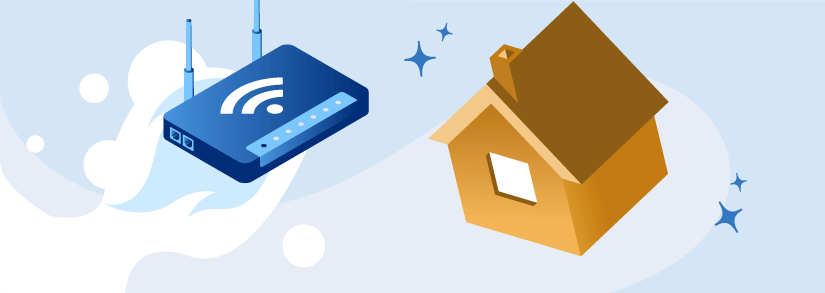The Impact of Having Fast Internet For Smart Homes

With so many items now connected to the Internet, it’s easy to get caught up in all the great new gadgets for your smart home and forget about the one thing that keeps everything running: your internet connection. What kind of internet speed does your smart home require?
The engine that keeps your smart home running is without a doubt your internet connection and more importantly, it’s speed and bandwidth. Installing too many smart gadgets without considering the bandwidth they consume might result in a slow connection, rendering all of those smart items useless.
Hence, it goes without saying that you need to have sufficient internet speed to manage everything on your network to keep your smart home alive. Luckily, many smart home and Internet of Things (IoT) peripherals don’t need a lot of bandwidth, and those who do may be readily accommodated.
In this blog, we’ll discuss the role of internet connection and the importance of fast internet for a smart home. However, before we dive in, let’s get a better understanding of the basics.
You may set your Google Home or Alexa to play classical music as an alarm or any musician you’d like to hear first thing in the morning.
What Is a Smart Home?
A smart home is a fancy term for a house that is largely run by internet-connected equipment. Smart gadgets are typically associated with security, energy saving, and convenience, and many of these devices may be managed by smart speech software that include digital assistants such as Amazon’s Alexa.
These devices are largely focused on providing better convenience to the users, for example, you can easily turn on the lights in your house and set your thermostats at the perfect temperature before you return home from work.
That being said, as these devices largely work only when connected to the internet, it’s crucial to have a connection with fast internet speed and good bandwidth.
Most Common Smart Home Devices
There are numerous sorts of smart gadgets that may be incorporated in your house to make it a smart home without making any substantial changes. Lightbulbs are simple to replace, and smart speakers are just plug-and-play.
The following are some of the most common types of smart gadgets to have in your home:
- Video doorbells
- Cameras
- Door locks
- Lightbulbs
- Thermostats
- Smart speakers and digital assistants
- Smoke detectors
Do Smart Devices Consume A Lot Of Data?
Technically, smart homes do not consume a lot of bandwidth because you are primarily transmitting tiny bits of data to and from servers, similar to how you would browse the internet or use your phone.
This implies that data is only delivered and received in the form of a command, such as through your Smart Voice assistants including Google Home or Amazon Alexa.
Accounting for the Bandwidth of Your Smart Home
While an individual smart device may not consume a lot of bandwidth, failing to account for the cumulative consumption of all your devices may lead to frustrating slowdowns or in some cases complete shutdowns.
As a result, you should ensure that your internet subscription provides fast internet speed to handle all of your usual online activities, as well as quite a bit more for your smart home.
For example, if your smart home does not have video recording capabilities, you just need to install 5 Mbps for every dozen smart devices. If your smart home includes video, such as a security video or doorbell cam, add 10 Mbps.
So, if you have two smart speakers and eight smart lamps, simply add 5 Mbps to your baseline suggestion, and you should be fine. On the other hand, add 10 Mbps if you have one smart speaker and one doorbell camera.
Furthermore, it’s crucial to check whether your router can handle the speed. Many smart home activities are local, that means they only use your home IoT technology and not the internet. All of these duties, however, are still directed through your router, which is why your router must be capable of handling your internet connection and then some.
Fortunately, most contemporary routers should be able to handle a smart home with ease. However, if your smart home is sluggish or glitchy and you’re probably utilizing a router that’s outdated, and that router is most likely the source of the problem.
Before you start installing smart devices, make sure you check your Wi-Fi connectivity both inside and outside the house. Make a map of dead zones to see if you can live with them.
How Fast Should Your Internet Connection Be For A Smart Home?
Several smart home gadgets do not need a lightning-fast internet connection. Thermostats and lightbulbs just need to connect to the network to accept orders from your smartphone or control panel, so there isn’t much ongoing data flow.
However, there is one significant exception to this: cameras. Doorbell cameras as well as other smart cameras that transfer images or videos will consume a significant amount of bandwidth.
The renowned Nest Cam can send 1080p HD footage at up to 4 Mbps. If you have a number of them uploading at the same time, you might quickly exhaust a sluggish connection, allowing no bandwidth for other activity.
Even if you don’t have cameras, you should examine the overall number of devices in your home that are active at the same time, including cellphones and laptops. However smart gadgets do not always consume a lot of bandwidth when used individually, when used in large numbers, they can strain your connection and slow down additional devices such as your smart TV.
So, if you have a considerable amount of smart devices in your home, especially ones that use cameras, you should consider getting a fast internet connection.
Making the Most of Your Internet Connection
Creating a smart home is often considered as an expensive ordeal, especially due to the high bandwidth required to maintain it. However, by using your devices wisely, this doesn’t need to be the case. In fact, it has never been easier, thanks to rising internet speeds and the comparatively modest needs of smart gadgets.
One approach to reduce your smart home gadgets’ internet use is to reduce the length of time they use the connection. Cameras can be configured to capture lower-resolution video, which can have a significant impact. Other gadgets usually include options that allow you to control how frequently they connect to the internet.
If you don’t want to give up your smart device utilization, you can always contact your ISP and try to negotiate a better contract at a higher speed. Occasionally providers have unique discounts that aren’t publicized, but if you contact and inquire, you could be surprised.
If you handle the situation appropriately, they may be ready to negotiate your pricing. Moreover, if you have other alternatives, you may always move to a new provider who offers higher speeds in exchange for a lower monthly fee.
What To Do If You’re Facing Slow Internet Issues In Your Smart Home?
The very first thing you must check is that you are not performing an active download or are engaged in a video chat, since these may be using internet resources. Try restarting your devices, modems, and router if you aren’t using any bandwidth-intensive apps. Repeat the test to determine whether your speed has improved.
If you continue to have poor Internet connections, you should inform your Internet Service Provider (ISP). They may need to modify settings on their end to guarantee that the proper internet speed is provided to your home.
Even after this, if the problem keeps recurring, you should consider changing your internet service provider. There are multiple providers, and you can make a decision by comparing their speed, pricing, features and other benefits.
If you have multiple smart devices, consider giving them a short, but logical name when you first set it up. Make sure it’s easy to remember!
Conclusion
With affordable prices of smart devices and great offers provided by internet service providers, creating a smart home has never been easier. Choose the right broadband provider to ensure you have fast internet and great bandwidth to make the most of your technologically-enabled home.
